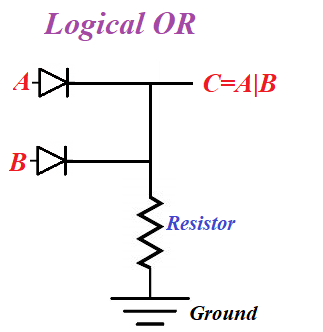Logical OR Implementation
Let's analyze how diodes can be used to implement operation OR of mathematical (and computer) logic.
The standard is that TRUE or 1 is represented by some positive potential on a wire relative to the ground, while FALSE or 0 is represented by zero potential relative to the ground.
Disjunction OR is represented by a symbol of addition + or a vertical bar |.
The rules are:
0 | 0 = 0
0 | 1 = 1
1 | 0 = 1
1 | 1 = 1
Now let's design a schema that represents a logical operation OR of two logical values.
Assume, the wires A and B, connected to corresponding anodes of two diodes, represent some logical values, TRUTH (1) or FALSE (0) and find the value represented by wire C on the following picture

There are four variations of values A and B:
A=0, B=0
A=0, B=1
A=1, B=0
A=1, B=1
For each of these cases we will determine the value at point C.
1. If A=0 and B=0, that is the potential is zero at both points relative to ground, there is no electric current anywhere. Even with cathode on any of the diodes heated, there is no current since there is no positive charge on anode to attract the electrons in the cloud produced by thermionic emission. So, at point C the potential is zero, that is C=0
2. Consider a case of A=0 and B=1, that is the potential is zero at point A, but is positive at point B relative to the ground.
The electrons in the cloud produced by thermionic emission on cathode opposite to point B will be attracted to positively charged anode at point B, thus creating a deficiency of electrons (positive potential) on this cathode.
New electrons from the neutral ground will compensate the loss of electrons on this positively charged cathode, but will be immediately dispatched to a thermionic emission cloud and attracted by positively charged anode at point B, thus maintaining a constant flow of electrons from the neutral ground through positively charged cathode to point B.
This process of electrons moving from the ground to positively charged cathode opposite to point B, to thermionic emission cloud and to point B will continue as long as point B has positive potential.
Therefore, the cathode opposite to point B will always be positively charged, and so is a wire at point C connected to it. That means that C=1.
3. If A=1 and B=0, situation is analogous to a previous one, except all the electrons will flow to point A. The potential at point C will be positive, that is C=1.
4. Case A=1 and B=1 is not much different. Now the electrons will flow from the ground to both points A and B. The point C will be positively charged, that is C=1.
As we see, if any one or both input potentials at points A and B equal to 1, the output C=1 as well. Only if both A=0 and B=0, the potential a C is zero, that is C=0.
That fully corresponds to the rules of logical OR operation.
Therefore, the circuit above is a proper electronic implementation of logical operation of disjunction.
Obviously, the real implementation requires some concrete values for voltage, resistance, characteristics of diodes etc. that we will not address here, as our purpose is to introduce only the principle behind this implementation.


No comments:
Post a Comment